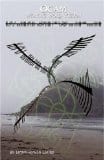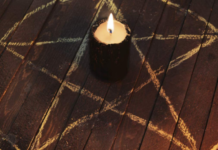
Ogam: Weaving Word Wisdom
, by Erynn Rowan Laurie
Megalithica Books, 9781905713028, 310 pp.
I must admit that I requested this book for review because I have only a passing acquaintance with the subject matter. I have reviewed dozens of books on Wicca/Witchcraft, Paganism, magick, Tarot, etc., all of which I am reasonably well-read on (as well as having personal experience to call upon). Every once in a while I like to find a subject I can approach as a novice reader, so I can see if the hypothetical average reader can make sense of what is being written.
The author makes a statement which should, in my opinion, be branded in the hearts and minds of every “eclectic” Pagan: “That said, these things [local spirits and personal ancestors] must be done with the utmost respect for the local people and traditions, and not stolen, twisted, and used without instruction or permission.”1 Far too many eclectics seem to feel that if it comes from a Pagan culture it is usable by any Pagan, anywhere, even without an understanding of the parent culture. Ms. Laurie recognizes that such behaviour is inappropriate, and for that, I applaud her.
I also applaud her candour in stating that she has melded traditional, verified knowledge with personal inspiration to fill in gaps. Such honesty should be commonplace, but is all too frequently lacking. She offers a foundation upon which the reader can build his/her own practice.
Ms. Laurie’s perspective on working with spirits and deities is a refreshingly different approach – no invoking, no summoning; no threatening, only relating to and working with the entities involved. One shouldn’t use other people, so why should we use other non-corporeal beings? Common courtesy and respect are the hallmarks of her approach. These are standards anyone can aspire to and live by.
While some readers might find the constant use of Gaelic for common terms disconcerting, it serves a most useful purpose. The constant exposure to these terms begins the inculcation which is necessary to make ohgam an effective part of daily life.
Although Ms. Laurie disclaims the title of scholar she, in my opinion, epitomizes the best of the scholarly approach to a subject. She has a deep personal knowledge augmented by the ability to find outside source when needed. In this way, she manages to convey information without overwhelming anyone. She enters into a discourse as opposed to a lecture, and is all the more appealing for doing so.
Ms. Laurie’s approach to spirituality is sure to offend people. On the one hand she sees the value of cultural heritage (as opposed to heritage based on a racial identity), which will offend many who have the attitude that, for example, only people whose ancestors came from Celtic lands can worship Celtic deities and work with Celtic spirits. On the other hand she firmly believes that if you are willing to study the originating culture you can integrate a non-cultural heritage into your own workings. This will offend those who feel that all love goddesses, for example, are the same so it doesn’t what name you use. The offensive part is the bit about studying, since many see spirituality as a “Chinese menu” (take 1 from column “A” and 3 from column “B”, and it doesn’t matter what you actually know about your choices).
And then there’s the bit about working to unite the community rather than splitting off and doing your own thing. How radical can she be?
Ms. Laurie perceives each ohgam as having components relating to the three realms that composed the Celtic view of the universe – Land, Sea, and Sky. The oghams are not merely an alphabet, they are a mnemonic device similar to (but very different from) the Kabbalah.
Each ogham is associated not only with a tree, with which most are familiar, but with an entire host of birds, animals, colours and sounds. Ms. Laurie explains these associations, giving traditional attributions, more modern understandings, and her own personal usages – being careful to distinguish each source.
Without a doubt, in my opinion, this is a very thorough, well-thought out book. While it is not an easy-to-read, fluffy work, it is not so authoritarian as to frighten away the novice. The reader needs to pay attention while reading to get the most from this book, and may need to go back and read over some sections, but will find himself more than amply repaid for the effort.
Although ogham is not a major interest for me, this book has found a spot on my reference shelf, as it should. There are facts to learn, insights to be gleaned, and images to ponder.
The author continually reminds the reader that the use of ogham is an intensely personal experience and that it is up to the individual to work with, and create, a personal system of correspondences. She also stresses the need to take your time and to make the ogam an integral part of your working. Don’t rush things. Remember that it took many years to develop the traditional relationships and correspondences in the traditional culture. Modifications caused by new lands and cultures will not occur immediately. Experiment and play with new ideas to see what develops for you.
If you have the slightest interest in Celtic studies, divination, or any of several other topics, this book is well worth the price.
- p. 36 [↩]








